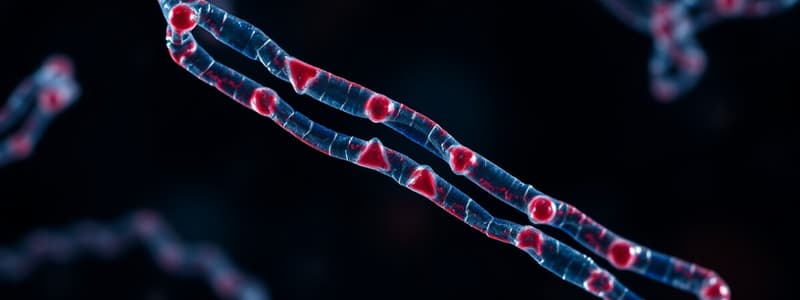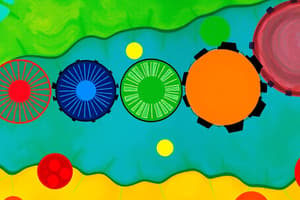Podcast
Questions and Answers
What phase of the cell cycle is primarily focused on the replication of chromosomes?
What phase of the cell cycle is primarily focused on the replication of chromosomes?
- Growth Stage 1 (G1)
- Growth Stage 2 (G2)
- Metaphase
- Synthesis Stage (S) (correct)
During which phase of mitosis do chromosomes condense and spindle fibers begin to form?
During which phase of mitosis do chromosomes condense and spindle fibers begin to form?
- Prophase (correct)
- Telophase
- Metaphase
- Anaphase
What occurs during the G2 phase of interphase?
What occurs during the G2 phase of interphase?
- Cell size decreases and energy levels drop.
- Chromosomes are replicated.
- Preparation for mitosis is finalized, including organelle production. (correct)
- Spindle fibers form and chromatin condenses.
Which of the following accurately describes the state of chromatin at the end of interphase?
Which of the following accurately describes the state of chromatin at the end of interphase?
What is the role of spindle fibers during metaphase?
What is the role of spindle fibers during metaphase?
Which event is not a characteristic of prophase?
Which event is not a characteristic of prophase?
Which of the following phases has the longest duration in the cell cycle?
Which of the following phases has the longest duration in the cell cycle?
What happens to the centrioles during metaphase?
What happens to the centrioles during metaphase?
What is the number of chromosomes in a human cell?
What is the number of chromosomes in a human cell?
During which phase of the cell cycle is DNA duplicated?
During which phase of the cell cycle is DNA duplicated?
Why is mitosis important for an organism?
Why is mitosis important for an organism?
Which phase of the cell cycle is the longest?
Which phase of the cell cycle is the longest?
What happens to chromosomes during mitosis?
What happens to chromosomes during mitosis?
What is the primary reason cells divide?
What is the primary reason cells divide?
How many chromosomes do dogs typically have?
How many chromosomes do dogs typically have?
Which statement is true about sex cells compared to somatic cells?
Which statement is true about sex cells compared to somatic cells?
What is the primary difference between prokaryotic and eukaryotic cells concerning their genetic material?
What is the primary difference between prokaryotic and eukaryotic cells concerning their genetic material?
What structure do eukaryotic chromosomes consist of?
What structure do eukaryotic chromosomes consist of?
What happens to sister chromatids during cell division?
What happens to sister chromatids during cell division?
Why does DNA change from chromatin to chromosome during cell division?
Why does DNA change from chromatin to chromosome during cell division?
Which statement about prokaryotic cells is correct?
Which statement about prokaryotic cells is correct?
In which cellular process does mitosis occur?
In which cellular process does mitosis occur?
What is the function of the centromere in a chromosome?
What is the function of the centromere in a chromosome?
Which type of cells are characterized by having membrane-bound organelles?
Which type of cells are characterized by having membrane-bound organelles?
What occurs during anaphase?
What occurs during anaphase?
Which force is involved in the separation of sister chromatids during anaphase?
Which force is involved in the separation of sister chromatids during anaphase?
What happens during telophase?
What happens during telophase?
Which structure disappears at the end of telophase?
Which structure disappears at the end of telophase?
What is the main distinction between cytokinesis in animal and plant cells?
What is the main distinction between cytokinesis in animal and plant cells?
Which of the following statements is true regarding daughter cells after cytokinesis?
Which of the following statements is true regarding daughter cells after cytokinesis?
What primarily occurs to chromosomes during telophase?
What primarily occurs to chromosomes during telophase?
Which of the following best describes spindle fibers?
Which of the following best describes spindle fibers?
Study Notes
Cell Types
- Two categories: Eukaryotic cells (have membrane-bound organelles) and prokaryotic cells (lack membrane-bound organelles).
- Eukaryotic cells are found in multicellular organisms like plants and animals, while prokaryotic cells are found in unicellular organisms like bacteria.
- Differences in organelles, genetic material, and chromosome structure distinguish the two.
Chromosome Structure
- DNA is located in the nucleus and controls all cellular activities, including cell division.
- Chromatin is long, thread-like DNA in a non-dividing cell.
- Chromosomes are doubled, coiled, short DNA in a dividing cell, made of two parts:
- Chromatid: two identical "sister" chromatids attached at the centromere.
- Centromere: the area in the middle where sister chromatids are attached.
- During cell division, sister chromatids separate and one goes to each new cell.
Number of Chromosomes
- Constant for all members of a species: humans have 46 chromosomes (23 pairs), dogs have 78 (39 pairs), goldfish have 94 (47 pairs), and lettuce has 18 (9 pairs).
- Constant throughout an individual's life.
- Constant for each cell in the body except sex cells, which only have half sets.
Cell Division
- Cells divide to allow organisms to grow, repair damaged tissue, and ensure efficient nutrient uptake.
- Mitosis is the division of the nucleus into two nuclei, each with the same number of chromosomes.
- Mitosis occurs in all somatic (body) cells, ensuring each new daughter cell has a complete set of chromosomes.
The Cell Cycle and Mitosis
- The cell cycle has three stages: Interphase, Mitosis, and Cytokinesis.
- Interphase: The cell carries out normal functions and prepares for division.
- G1 phase: The cell increases in size, synthesizes new proteins, and organelles.
- S phase: The cell duplicates its DNA.
- G2 phase: The cell prepares for mitosis by producing organelles and molecules needed for division.
- Mitosis: The nucleus divides into two equal parts.
- Cytokinesis: The separation of two nuclei and cell contents into two daughter cells.
Stages of Mitosis
- Prophase: Chromosomes condense, spindle fibers form, and chromosomes are captured by spindle fibers.
- Metaphase: Chromosomes line up along the equator of the cell, attached to spindle fibers.
- Anaphase: Sister chromatids separate, pulled toward opposite poles by shortening spindle fibers.
- Telophase: Two new nuclear membranes form around the chromosomes, the spindle fibers disappear, chromosomes uncoil, and the cell begins to divide.
Cytokinesis
- Cytokinesis is the division of cytoplasm after telophase.
- Animal cells form a cleavage furrow to divide.
- Plant cells form a cell plate to divide.
- Both daughter cells are genetically identical to the parent cell.
Studying That Suits You
Use AI to generate personalized quizzes and flashcards to suit your learning preferences.
Related Documents
Description
Explore the fundamental differences between eukaryotic and prokaryotic cells, as well as the intricate structure of chromosomes. This quiz covers the organization of DNA, chromatin, and the process of cell division. Understand how these concepts are crucial for the functioning of living organisms.




